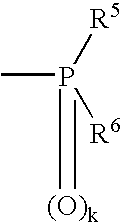Bicyclic compound, production and use thereof
a technology of bicyclic compounds and compound compounds, applied in the field of new bicyclic compounds, can solve the problems of insufficient treatment efficiency
- Summary
- Abstract
- Description
- Claims
- Application Information
AI Technical Summary
Benefits of technology
Problems solved by technology
Method used
Image
Examples
example 2
(Preparation of Compound 2)
[0365] To a solution of 8-[4-(2-butoxyethoxy)phenyl]-1-propyl-1,2,3,4-tetr-ahydro-1-benzazocine-5-carboxylic acid (180 mg) in THF (10 ml) were added a drop of DMF and then thionylchloride (0.04 ml) at 0.degree. C. After stirring at room temperature for 30 minutes under a nitrogen atmosphere, the mixture was added to a solution of 4-[[N-methyl-N-(tetrahydropyran-4--yl)amino]methyl]aniline (118 mg), and triethylamine (1.08 g) in tetrahydrofuran (15 ml) at 0.degree. C. After stirring at room temperature for 1.5 hours under a nitrogen atmosphere, water was added and the mixture was extracted with ethyl acetate. The organic layer was washed with saturated salt solutions, and dried over magnesium sulfate. After distilling off the solvent under reduced pressure, the residue was separated and purified by silica gel column chromatography (ethyl acetate:methanol=8:1) to obtain yellowish amorphous 8-[4-(2-butoxyethoxy)phenyl]-1-propyl-N-[4-[[N-methyl-N-(tetrahydropyr...
example 3
(Preparation of Compound 3)
[0367] To a solution of 8-[4-(2-butoxyethoxy)phenyl]-1-propyl-1,2,3,4-tetr-ahydro-1-benzazocine-5-carboxylic acid (900 mg) in tetrahydrofuran (15 ml) were added a drop of DMF and then thionylchloride (0.2 ml). The mixture was stirred for 1 hour under a nitrogen atmosphere. After distilling off the solvent and the excess thionylchloride under reduced pressure, the residue was redissolved in THF (15 ml). The solution was added dropwise to a solution of S-(4-aminophenyl)O-benzylcarbonothioate (534 mg) and triethylamine (1.4 ml) in THF (15 ml) at 0.degree. C. under an argon atmosphere. After the dropwise addition, the solution was allowed to warm to room temperature and stirred overnight under an argon atmosphere. After addition of methanol (30 ml) and further 1N sodium hydroxide (10.3 ml), the solution was stirred for 30 minutes under an argon atmosphere. Then, 5-chloromethyl-1-propylimidazole hydrochloride (482 mg) was added to the solution, and the mixture ...
example 4
(Preparation of Compounds 4 and 5)
[0370] A solution of 70% 3-chloroperbenzoic acid (316 mg) in dichloromethane (15 ml) was added dropwise to a solution of 8-[4-(2-butoxylethoxy)phenyl]-1-propyl-N-[4-[[[1-propylimidazol-5-yl]meth-yl]sulfanyl]phenyl]-1,2,3,4-tetrahydro-1-benzazocine-5-carboxamide (570 mg) in dichloromethane (15 ml) at -78.degree. C. After removal of the dry ice-acetone bath, an aqueous solution of sodium thiosulfate was added to the solution with a vigorous stirring. The resultant solution was allowed to warm to room temperature and stirred for 30 minutes. After extraction with ethylacetate, the organic layer was washed with saturated sodium bicarbonate solution and saturated saline, and dried over magnesium sulfate. After distilling off the solvent under reduced pressure, the residue was separated and purified by basic silica gel column chromatography (ethylacetate) to obtain yellowish amorphous 8-[4-(2-butoxyethoxy)phenyl]-1-propyl-N-[4-[[[1-propylimidazol-5-yl]meth...
PUM
| Property | Measurement | Unit |
|---|---|---|
| Time | aaaaa | aaaaa |
| Electric charge | aaaaa | aaaaa |
| Electrical conductance | aaaaa | aaaaa |
Abstract
Description
Claims
Application Information
 Login to View More
Login to View More - R&D
- Intellectual Property
- Life Sciences
- Materials
- Tech Scout
- Unparalleled Data Quality
- Higher Quality Content
- 60% Fewer Hallucinations
Browse by: Latest US Patents, China's latest patents, Technical Efficacy Thesaurus, Application Domain, Technology Topic, Popular Technical Reports.
© 2025 PatSnap. All rights reserved.Legal|Privacy policy|Modern Slavery Act Transparency Statement|Sitemap|About US| Contact US: help@patsnap.com



